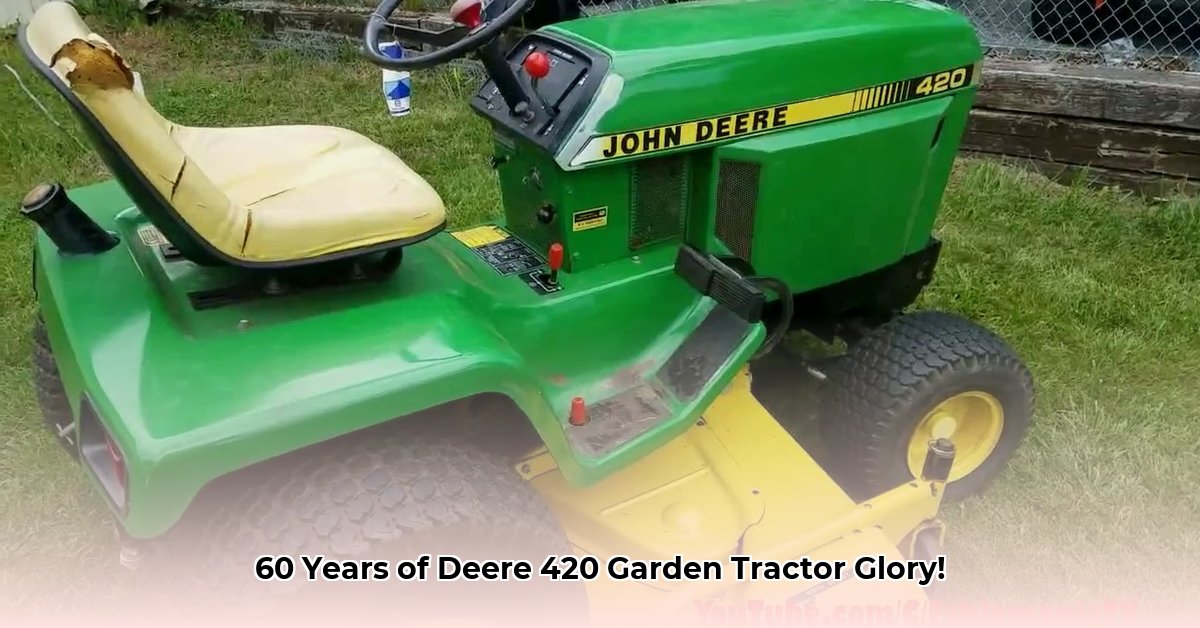
The iconic John Deere 420 nameplate evokes images of robust farm machinery. However, this designation encompasses two vastly different tractors, separated by decades of technological advancement and shifting societal needs. This article delves into the distinct features, historical context, and restoration considerations of these two distinct models, revealing a fascinating story of agricultural and landscaping equipment evolution. For kids interested in tractors, check out this John Deere toy.
The Original Workhorse: The 1956-1958 John Deere 420
Imagine the mid-1950s: post-World War II America, characterized by burgeoning farms and the increasing mechanization of agriculture. The first John Deere 420, manufactured in Dubuque, Iowa, emerged as a powerful solution for the era's demanding farming tasks. This wasn't a dainty lawnmower; it was a robust machine built to handle heavy-duty work. Its impressive 1.9-liter, two-cylinder engine provided the muscle to tackle challenging field work. Furthermore, its fuel flexibility was remarkable for its time—capable of running on gasoline, various alternative fuels, or even liquid propane gas, a testament to the resourcefulness of the period. Weighing in at a substantial 3250 pounds, its significant lifting capacity (precise figures are elusive, but certainly impressive for the era) showcased its capability for hauling and heavy lifting. The transmission, a basic four or five-speed unsynchronized gearbox, prioritized functionality above all else. This was a true workhorse, designed for clearing fields, hauling heavy loads, and performing a wide range of demanding farm operations. Isn't it remarkable how far technology has come?
The Suburbanite's Choice: The 1983-1991 John Deere 420
Fast forward to the 1980s. The landscape had dramatically shifted. Suburban sprawl was rapidly expanding, creating a demand for smaller, more manageable equipment for residential lawn care. Enter the second iteration of the Deere 420, assembled in Horicon, Wisconsin. A stark contrast to its predecessor, this model was significantly lighter, weighing in at only 993 pounds, and featured a less powerful yet efficient 781cc, two-cylinder engine, perfectly suited for home use. Notably, this model incorporated a hydrostatic transmission—a significant departure—providing a smoother and more user-friendly experience compared to its predecessor's unsynchronized gearbox. Running solely on gasoline, it simplified operation and eliminated the fuel-type complexities of the original. The 1980s model also exhibited a marked stylistic shift, aligning with the aesthetic preferences of the suburban landscape. Does this difference in weight and engine size underscore the changing needs of the market?
Comparing the Titans: A Side-by-Side Analysis
A direct comparison of these two tractors clearly highlights their fundamental differences:
| Feature | 1956-1958 John Deere 420 | 1983-1991 John Deere 420 |
|---|---|---|
| Engine | 1.9L 2-cylinder | 781cc 2-cylinder |
| Fuel Options | Gasoline, Multiple Fuels | Gasoline |
| Weight | 3250 lbs | 993 lbs |
| Transmission | 4/5-speed unsynchronized | Hydrostatic |
| Intended Use | Heavy-duty farm work | Residential lawn care |
| Lift Capacity | High (exact figures unavailable) | 640 lbs |
Beyond the Specifications: A Reflection of Societal Change
These specifications tell a compelling story extending beyond mere engineering details. The original 420 is a product of an era that demanded strength, resourcefulness, and adaptability in its machinery. In contrast, the later model showcases a societal shift towards convenience and the specialization of equipment for specific tasks. This evolution mirrors the dramatic transformation from a predominantly agrarian society to one increasingly defined by suburban living. This adaptability highlights John Deere's ability to respond dynamically to evolving market demands.
Restoring a 1956-1958 John Deere 420: A Labor of Love
Restoring a classic John Deere 420 is a rewarding but complex project requiring patience, meticulous attention to detail, and access to resources. The process often involves significant disassembly, thorough cleaning, part sourcing (which can be challenging due to the age of the machine), engine overhaul (potentially requiring professional expertise), and methodical reassembly. Online forums dedicated to vintage tractors offer an invaluable support network and a wealth of information for enthusiasts undertaking such projects.
Key Steps in Restoration:
- Assessment: Thoroughly evaluate the tractor's condition.
- Disassembly: Carefully dismantle the tractor, documenting each step with photos.
- Parts Sourcing: Locate and acquire necessary parts, potentially utilizing online resources and specialized retailers.
- Engine Overhaul: Possibly enlist professional assistance for engine rebuilding and repair.
- Reassembly: Meticulously reassemble the tractor, referencing the disassembly documentation.
- Testing: Thoroughly test the tractor’s functionality.
- Maintenance: Implement a regular maintenance schedule for long-term preservation.
This journey of restoration speaks to a deeper appreciation for sustainable agricultural practices and the preservation of valuable historical artifacts. The challenge, and the ultimate reward, of restoring a classic John Deere 420 tractor is a fulfilling experience for those with a passion for mechanical history and agricultural heritage.